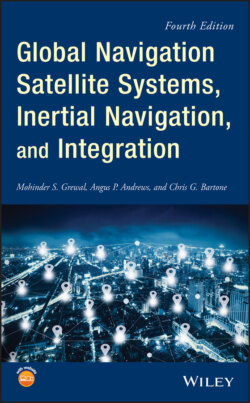Читать книгу Global Navigation Satellite Systems, Inertial Navigation, and Integration - Mohinder S. Grewal - Страница 28
1.2.3.1 Galileo Navigation Services
ОглавлениеThe EU intends the Galileo system to provide various levels of services.
Open service (OS). The OS provides signals for positioning and timing, is free of direct user charge, and is accessible to any user equipped with a suitable receiver, with no authorization required. The OS provides dual‐frequency operation in the L1/E1 and L5/E5 frequency bands. The Galileo E1 L1C signal centered at 1575.42 MHz is compatible with the modernized GPS L1C signal transmitted by GPS III satellites. The Galileo E5a signal at 1176.45 MHz is part of a combined AltBOC signal. Modernized GNSS receiver equipment may use a combination of Galileo and GPS signals, thereby improving performance in severe environments such as urban canyons and heavy vegetation.
Commercial service (CS). The CS service is intended for applications requiring performance higher than that offered by the OS. Users of this service pay a fee for the added value. CS is implemented by adding two additional signals to the OS signal suite. The additional signals are protected by commercial encryption, and access protection keys are used in the receiver to decrypt the signals. Typical value‐added services include service guarantees, precise timing, multifrequency ionospheric delay measurements, local differential correction signals for very high‐accuracy positioning applications, and other specialized requirements. These services will be developed by service providers, which will buy the right to use the multifrequency commercial signals from the Galileo operator.
Public regulated service (PRS). The PRS is an access‐controlled service for government‐authorized applications. It is expected to be used by groups such as police, coast guards, and customs. The signals will be encrypted, and access by region or user group will follow the security policy rules applicable in Europe. The PRS will be operational at all times and in all circumstances, including periods of crisis. A major feature of PRS is the robustness of its signal, which protects it against jamming and spoofing.
Search and rescue (SAR). The SAR service is Europe's contribution to the international cooperative effort on humanitarian SAR. It will feature near‐real‐time reception of distress messages from anywhere on Earth, precise location of alerts (within a few meters), multiple satellite detection to overcome terrain blockage, and augmentation by the four low Earth orbit (LEO) satellites and the three geostationary satellites in the current Cosmicheskaya Sistema Poiska Avariynyh Sudov‐Search and Rescue Satellite Aided Tracking (COSPAS‐SARSAT) system.
